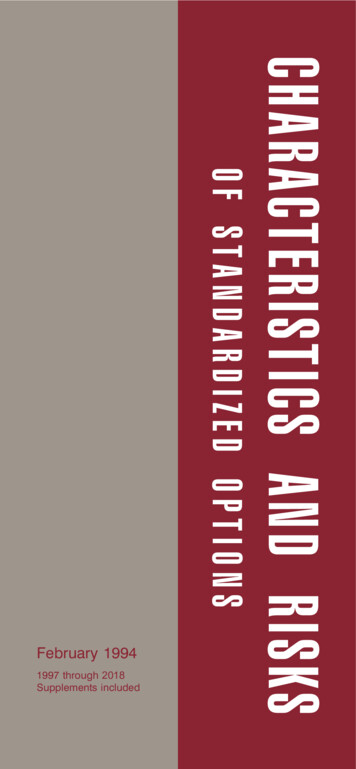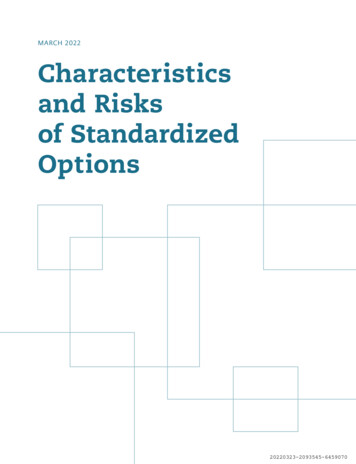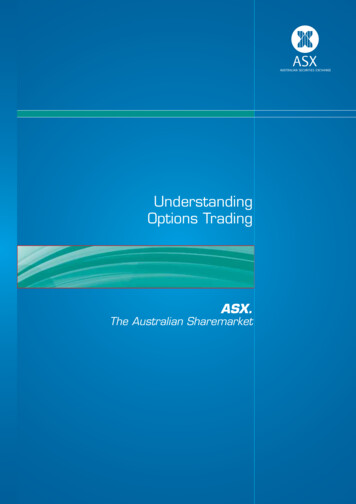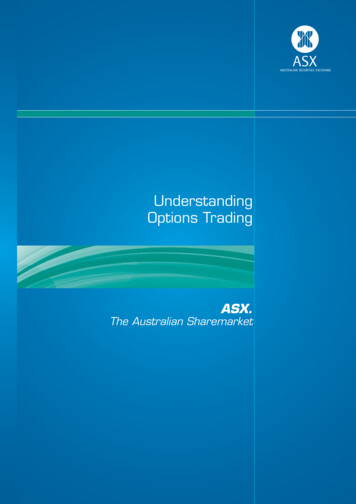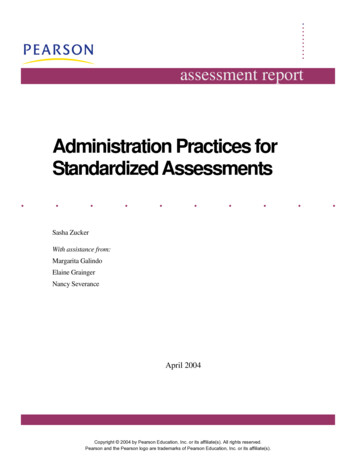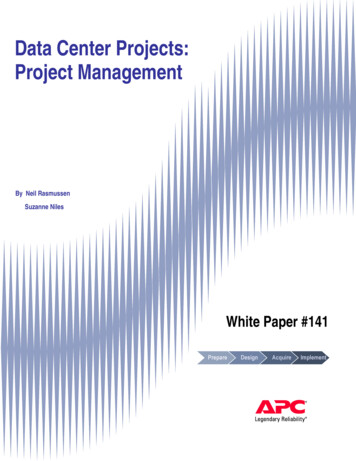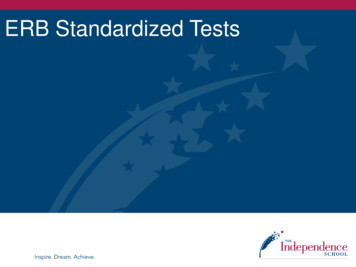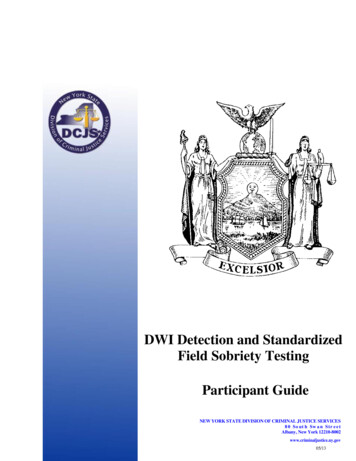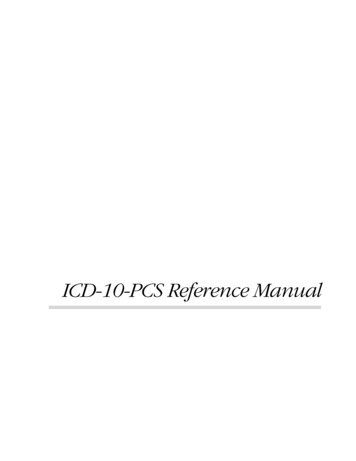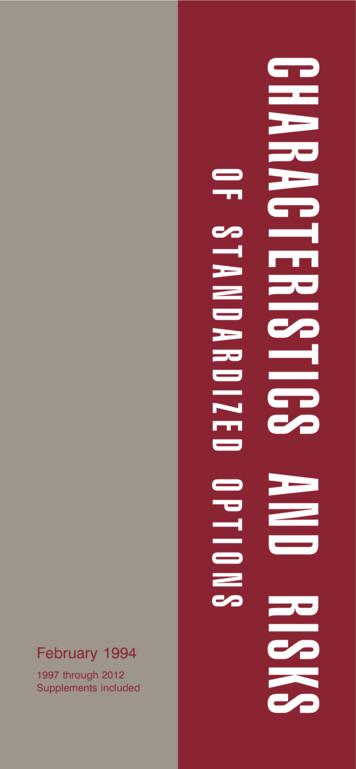
Transcription
1997 through 2012Supplements includedCHARACTERISTICS AND RISKSOF STANDARDIZED OPTIONSFebruary 1994
BATS Exchange, Inc.8050 Marshall DriveLexena, Kansas 66214C2 OPTIONS EXCHANGE, INCORPORATED400 South LaSalle StreetChicago, Illinois 60605CHICAGO BOARD OPTIONS EXCHANGE,INCORPORATED400 South LaSalle StreetChicago, Illinois 60605INTERNATIONAL SECURITIESEXCHANGE, LLC60 Broad StreetNew York, New York 10004NASDAQ OMX BX, INC.101 Arch StreetBoston, Massachusetts 02110NASDAQ OMX PHLX, INC.1900 Market StreetPhiladelphia, Pennsylvania 19103NASDAQ STOCK MARKET, LLCOne Liberty Plaza165 BroadwayNew York, New York 10006NYSE AMEX LLC11 Wall StreetNew York, New York 10005NYSE ARCA, INC.100 South Wacker DriveChicago, Illinois 606061994 American Stock Exchange, LLC, Chicago BoardOptions Exchange, Incorporated, New York Stock Exchange,Inc., NYSE Arca, Inc. and Philadelphia Stock Exchange, Inc.
CHARACTERISTICS ANDRISKS OFSTANDARDIZED OPTIONSTABLE OF CONTENTSPageCHAPTER I—INTRODUCTION . . . . . . . . . . . . . .1CHAPTER II—OPTIONS NOMENCLATURE . . . . . .5CHAPTER III—OPTIONS ON EQUITY SECURITIES 18Features of Stock Options . . . . . . . . . . . . . . . . . 18CHAPTER IV—INDEX OPTIONS . . . . . . . . . . . . . 23About Indexes . . . . . . . . . . . . . . . . . . . . . . . . 23Features of Index Options . . . . . . . . . . . . . . . . . 26CHAPTER V—DEBT OPTIONS . . . . . . . . . . . . . . 29Rates, Yields and Prices of Debt Securities . . . . . . . 29Treasury Securities . . . . . . . . . . . . . . . . . . . . . . 31Yield-Based Options . . . . . . . . . . . . . . . . . . . . . 32CHAPTER VI—FOREIGN CURRENCY OPTIONS . . 35Market for Foreign Currencies . . . . . . . . . . . . . . . 36Special Characteristics of Foreign Currency Options . 37Special Features of Dollar-DenominatedCurrency Options . . . . . . . . . . . .Cross-Rate Foreign Currency Options .Special Features of Cross-Rate OptionsCash-Settled Foreign Currency OptionsForeign.CHAPTER VII—FLEXIBLY STRUCTURED OPTIONSSpecial Features of Flexibly Structured Options . . . .CHAPTER VIII—EXERCISE AND SETTLEMENT . . .How to Exercise . . . . . . . . . . . . . . . . . . . . . . .Assignment . . . . . . . . . . . . . . . . . . . . . . . . . .Settlement . . . . . . . . . . . . . . . . . . . . . . . . . . .CHAPTER IX—TAX CONSIDERATIONS,TRANSACTION COSTS AND MARGINREQUIREMENTS . . . . . . . . . . . . . . . . . . . . .Tax Considerations . . . . . . . . . . . . . . . . . . . . . .Transaction Costs . . . . . . . . . . . . . . . . . . . . . .Margin Requirements . . . . . . . . . . . . . . . . . . . .CHAPTER X—PRINCIPAL RISKS OF OPTIONSPOSITIONS . . . . . . . . . . . . . . . . . . . . . . . . .Risks of Option Holders . . . . . . . . . . . . . . . . . .Risks of Option Writers . . . . . . . . . . . . . . . . . . .Other Risks . . . . . . . . . . . . . . . . . . . . . . . . . .Special Risks of Index Options . . . . . . . . . . . . . .Special Risks of Debt Options . . . . . . . . . . . . . . .Special Risks of Foreign Currency Options . . . . . . .Special Risks of Flexibly Structured Options . . . . . .CHAPTER XI—SCOPE AND LIMITATIONS OFTHIS BOOKLET . . . . . . . . . . . . . . . . . . . . . .SUPPLEMENTSDecember 1997 . . . . . . . . . . . . . . . . . . . . . . .March 2000 . . . . . . . . . . . . . . . . . . . . . . . . . .January 2004 . . . . . . . . . . . . . . . . . . . . . . . . .April 2007 . . . . . . . . . . . . . . . . . . . . . . . . . . .May 2007 . . . . . . . . . . . . . . . . . . . . . . . . . . .June 2007 . . . . . . . . . . . . . . . . . . . . . . . . . . .June 2008 . . . . . . . . . . . . . . . . . . . . . . . . . . .December 2009 . . . . . . . . . . . . . . . . . . . . . . .May 2010 . . . . . . . . . . . . . . . . . . . . . . . . . . .January 2011 . . . . . . . . . . . . . . . . . . . . . . . . .March 2011 . . . . . . . . . . . . . . . . . . . . . . . . . .January 2012 . . . . . . . . . . . . . . . . . . . . . . . . 698100105114122148161167175183
APRIL 2007SUPPLEMENTThe February 1994 edition of the booklet entitledCharacteristics and Risks of Standardized Options (the‘‘booklet’’) is amended as provided below. The changespertain to non-rate modified cash-settled foreign currency options and rate-modified cash-settled foreign currency options. This supplement supersedes andreplaces the January 2007 supplement.On page 38, the second paragraph under the heading ‘‘Special Features of Dollar-Denominated Foreign Currency Options’’ is deleted and replaced with the following:NON-RATE-MODIFIED CASH-SETTLEDFOREIGN CURRENCY OPTIONSExercise prices for currently available dollar-denominated options on foreign currencies (other thanrate-modified currency options, as described below) arestated in units of U.S. currency (e.g., cents or hundredthsof a cent) per unit of foreign currency. In order to determine the total exercise price per contract, it is necessaryto know the unit of U.S. currency used for options on theparticular foreign currency, and to multiply the statedexercise price by the unit of trading for such options. Forexample, at the date of this booklet, dollar-denominatedBritish pound options are expressed in U.S. cents perunit, and dollar-denominated Japanese yen options areexpressed in hundredths of U.S. cents per unit.On page 38, the following is inserted immediatelyfollowing the second ‘‘EXAMPLE’’ at the end of the page:Readers should note, however, that certainexchanges may express exercise prices in other unconventional ways. For example, an exercise price stated as 100.50 may in reality mean 1.0050. Readers need tobe sure they fully understand the various conventionsused by the exchanges on which they trade in quotingexercise prices.On page 39, the second paragraph is deleted andreplaced with the following:Premiums for currently available dollar-denominatedoptions on foreign currencies (other than rate-modified currency options, as described below) are expressed in unitsof U.S. currency per unit of foreign currency. In order tocalculate the cost of the option, it is necessary to know theunit of U.S. currency used for options on the particular100
foreign currency. For example, at the date of this booklet,premiums for currently available dollar-denominated Swissfranc options are expressed in U.S. cents, and premiumsfor currently available dollar-denominated Japanese yenoptions are expressed in hundredths of U.S. cents.On page 39, the following are deleted: (a) the sentence immediately following the first ‘‘EXAMPLE,’’ (b) thesecond ‘‘EXAMPLE,’’ and (c) the sentence immediatelyfollowing the second ‘‘EXAMPLE.’’On page 39, the following is inserted immediatelybefore the last paragraph:Readers should note, however, that certainexchanges may express premiums in other unconventional ways. Readers need to be sure they fully understand the various conventions used by the exchanges onwhich they trade in quoting premiums.The first paragraph under the heading ‘‘Cash-SettledForeign Currency Options,’’ which is the last paragraphon page 43, is deleted and the following sentence isadded at the beginning of the first paragraph on page 44:At the date of this booklet, dollar-denominatedcash-settled foreign currency options have also beenapproved for trading.The last four paragraphs on page 44 are deleted andreplaced with the following:EXAMPLE: If the exercise price of a cash-settled,dollar-denominated call option on euros is 1.2500 pereuro, the exercise settlement value of the euro is determined to be 1.2607 and the option covers 10,000 euros,then the cash settlement amount for the option will be( 1.2607 1.2500) 10,000 107.00.Cash-settled foreign currency options may be automatically exercised on the expiration date if in the moneyor if in the money by a certain amount. See the discussion in Chapter VIII under ‘‘How to Exercise.’’The exercise settlement value for cash-settled foreigncurrency options will be based on an exchange rate forthe underlying foreign currency from a source selectedby the market on which the options trade as set forth inexchange rules. In the case of rate-modified foreign currency options, the options market on which the optionsare traded would calculate and disseminate the underlying rate. In either case this rate may be based on a rateannounced by the Federal Reserve Bank of New York, bidand offer quotations from a sampling of participants in theinterbank spot market for the underlying foreign currency,the rate reported by a recognized pricing service, or some101
other widely-available rate. The time as of which the exercise settlement value is calculated and the method ofcalculation are determined by the options market onwhich the options are traded and may be changed by it atany time. Any such change may be made applicable tooptions outstanding at the time of the change.If OCC determines that the exercise settlementvalue of the underlying foreign currency for any series ofcash-settled foreign currency options is unreported,inaccurate, unreliable, unavailable, or inappropriate forpurposes of calculating the cash settlement amount ofsuch series, OCC has the authority to suspend the settlement obligations of the exercising and assigned ClearingMembers of options of such series or to fix the cashsettlement amount for exercised options of such series orto do both. In the event of such a suspension, OCC will fixa new settlement date after OCC determines that theexercise settlement value is available or after OCC fixesthe cash settlement amount.If OCC determines to fix the cash settlementamount, it will act through an adjustment panel that willuse its judgment as to what is appropriate for the protection of investors and the public interest. For a descriptionof adjustment panels, see ‘‘Adjustment and AdjustmentPanels’’ in Chapter II. The panel may fix the cash settlement amount using the reported price or value of theunderlying foreign currency at such time, or representinga combination or average of prices or values at such timeor times, and reported in such manner, as the paneldeems appropriate.If an adjustment panel delays fixing a cash settlement amount for a series of cash-settled foreign currencyoptions past the last trading day before expiration of thatseries, normal expiration exercise procedures will notapply to the affected series. Instead, exercise settlementwill be postponed until the next business day followingthe day when the adjustment panel fixes the cash settlement amount, and each long position in the affectedseries will be treated as having been exercised if the cashsettlement amount per contract for that series is 1.00 ormore. If the cash settlement amount per contract is lessthan 1.00, the option will be treated as having expiredunexercised. As a result of these procedures, holders ofexpiring cash-settled foreign currency options may notknow whether their options have been exercised, andwriters of such options may not know whether they havebeen assigned an exercise, until after the expiration date.An adjustment panel’s determinations shall be conclusive, binding on all investors, and not subject to review.102
RATE-MODIFIED CASH-SETTLEDFOREIGN CURRENCY OPTIONSA rate-modified currency option is a type of foreigncurrency option that may be thought of as an option onan underlying exchange rate between two currencies.The holder of a rate-modified currency option receives inU.S. dollars the difference between the modified rate andthe exercise price multiplied by a multiplier (e.g.,USD 100). In this respect, rate-modified currencyoptions resemble cash-settled index options where theindex is an exchange rate between two currencies.Exchange rates in the spot market are expressed as thenumber of units of one currency (‘‘currency 1’’) requiredto purchase a single unit of a second currency (‘‘currency 2’’), and for each pairing of the world’s major currencies, there is a convention as to which currency iscurrency 1 and which is currency 2. You should be awarethat the exchange rates underlying rate-modified currency options may or may not be stated in the same waythat they are conventionally quoted in the spot market.For example, exchange rates between the U.S. dollar andthe euro are generally quoted as the number of dollarsrequired to purchase a single euro; but the rate underlying a rate-modified currency option could be stated asthe number of euros required to purchase a single dollar.You should therefore be certain that you understand themeaning of an underlying exchange rate.In the case of rate-modified currency options, theunderlying exchange rate may be multiplied by a‘‘rate-modifier,’’ such as 1, 10 or 100, to create an underlying value that more closely resembles a conventionalindex value. Exercise prices would, of course, also beexpressed in terms of the rate-modified values.EXAMPLE: A rate-modifier of 100 may be applied tothe exchange rate between U.S. dollars (‘‘USD’’) andSwiss francs (‘‘CHF’’) in order to obtain the underlyingexchange rate for USD/CHF rate-modified currencyoptions. If the current exchange rate in the USD/CHFspot market is 1.24 Swiss francs per dollar, the currentrate-modified exchange rate would be stated as(1.24 100) 124. For example, an exercise price of1.25 Swiss francs per dollar would be expressed as 125.As in the case of an index option, the premiums andexercise settlement values of rate-modified currencyoptions are determined using a multiplier, e.g., USD 100.EXAMPLE: A rate-modified USD/CHF call option hasan exercise price of 125. The USD/CHF exchange rate inthe spot market at the time the exercise settlement value isfixed is 1.27 Swiss francs per dollar, meaning that the103
underlying rate-modfied value is (1.27 100) 127. Theoption is in the money. The exercise settlement value ofthe option is (127 125) 100 200.Do not confuse the rate-modifier with the multiplier.They serve different purposes and may or may not havethe same numeric value.EXAMPLE: Assume that the exchange rate underlying a rate-modified call option on the exchange ratebetween the U.S. dollar and the Mexican peso is statedas Mexican pesos per U.S. dollar (USD/MXN). Therate-modifier could be 10 and the multiplier could be 100. If the exercise price of the option is 11 Mexicanpesos per U.S. dollar, it is stated as 11 10 110. If theunderlying exchange rate is 11.2 at the time the option isexercised, the exercise settlement value is (112 110) 100 200.Note that, as in the case of index options, the multiplier determines the cash value of an option that is in themoney by a specified amount. Like index options, andunlike other cash-settled currency options, arate-modified currency option has no unit of trading—itdoes not relate to a specified quantity of an underlyingcurrency.The multiplier is also used in determining the totalpremium for a rate-modified currency option. For example, if a premium is quoted as .50 and the multiplier is 100, the total premium for a single option is 50.The paragraph numbered 12 on page 87 is deleted.104
MAY 2007SUPPLEMENTThe February 1994 edition of the booklet entitledCharacteristics and Risks of Standardized Options (the‘‘Booklet’’) is amended as follows to reflect certainchanges in OCC’s rules as well as the rules of certainoptions markets.The changes in Part I reflect modifications made tothe definition of ‘‘ordinary cash dividend or distribution’’(i.e., cash dividends and distributions for which noadjustment is made). The changes in Part II reflectchanges made to eliminate the need to round adjustedexercise prices in certain circumstances and to providemore precise compensation for fractional shares eliminated by rounding.Parts III-V of this Supplement supersede andreplace the February 2003 Supplement to the Booklet.Part III pertains to options on interests in investment companies and similar entities. Part IV pertains to specialexercise settlement procedures or restrictions that maybe imposed upon the occurrence of certain extraordinaryevents. Part V discloses that a registration statement andprospectus for the options covered by the Booklet are nolonger available.Part VI pertains to an expansion of OCC’s authorityto adjust the multiplier for yield-based Treasury optionsand to fix the cash settlement amount for such options incertain circumstances. Part VII reflects the adoption ofrules by certain options markets that permit, in very limited circumstances, the cancellation or adjustment of atransaction entered into at a premium based on an erroneously reported value for the underlying interest.Part VIII, which supersedes paragraph 1 of theMarch 2000 Supplement to the Booklet, pertains to theacceleration of the expiration date of options on equitysecurities in certain circumstances.Part I. Definition of Ordinary CashDividend or Distribution.The fourth paragraph on page 19 is amended toread as follows:As a general rule, no adjustment is made for ordinarycash dividends or cash distributions. A cash dividend ordistribution announced prior to February 1, 2009, will generally be considered ‘‘ordinary’’ unless it exceeds 10% of theaggregate market value of the underlying security outstanding as of the close of trading on the declarationdate. The same rule will continue to apply on and after that105
date with respect to options series designated by OCCas ‘‘grandfathered’’ for purposes of this rule (i.e., seriesopened prior to publication of this Supplement thatremain outstanding on February 1, 2009). In the case ofall other options series, a cash dividend or distributionannounced on or after February 1, 2009, will generally beconsidered ‘‘ordinary,’’ regardless of size, if OCCbelieves that it was declared pursuant to a policy or practice of paying such dividends or distributions on a quarterly or other regular basis (and no adjustment will normally be made for any cash dividend or distribution thatamounts to less than 12.50 per contract). As an exception to the general rule, options on fund shares will generally be adjusted for capital gains distributions even ifmade on a regular basis, and adjustments may be madefor certain other distributions in respect of fund shares inspecial circumstances described in OCC’s rules, provided in each case that the amount of the adjustmentwould be .125 or more per fund share. Determinationswhether to adjust for cash dividends or distributions notcovered by the preceding rules, or when other specialcircumstances apply, are made on a case-by-case basis.Part II. Adjustment of Exercise Prices.The first seven paragraphs on page 20 of the Bookletare deleted in their entirety, and the following material isinserted in lieu thereof.Stock dividends, stock distributions and stock splitsmay result in an adjustment of the number of optionsheld or written or the number of underlying shares, and insome cases may also result in an adjustment of the exercise price.Stock Options with Exercise Prices Stated inFractionsAs of the date of this Supplement, exercise pricesfor stock options are stated in points and fractions of apoint (e.g., 203 8 or 301 2). The smallest fraction is 1 8. Thefollowing adjustment rules apply to any series of stockoptions whose exercise price is stated in points and fractions of a point:As a general rule, a 2 for 1 or a 4 for 1 stock split,stock distribution or stock dividend will result in the number of outstanding options being proportionatelyincreased and the exercise price being proportionatelydecreased.EXAMPLE: Before a 2 for 1 stock split, an investorholds an option on 100 shares of XYZ stock with anexercise price of 60. After adjustment for the split, he willhold two XYZ options, each on 100 shares and each withan exercise price of 30.A stock dividend, stock distribution or stock splitother than a 2 for 1 or a 4 for 1 distribution or split willnormally result in an adjustment in the number of sharesdeliverable upon exercise, while the aggregate exerciseprice for the contract remains unchanged.106
EXAMPLE: An investor holds a call option covering100 shares of XYZ stock with an exercise price of 50resulting in an aggregate exercise price for the contractof 5,000 ( 50 100). After a 3 for 2 split, the deliverablecould be increased to 150 shares while the nominal exercise price remained 50. In that case, upon exercise ofthe adjusted option, the investor would still pay 5,000( 50 100, not 50 150), but would receive150 shares of XYZ stock instead of 100.Note in the preceding example that, although thenumber of shares deliverable was adjusted to be 150, thenumber by which the unadjusted exercise price of 50was multiplied to determine the total exercise price continued to be 100 rather than 150. Similarly, premium quotations would continue to be multiplied by 100 to obtainthe total premium to be paid for a single option.Stock Options with Exercise Prices Stated inDecimalsIn the future, the exchanges may introduce stockoptions with exercise prices stated in points anddecimals (e.g., 20.15 or 30.80). The following adjustmentrules would apply to any series of stock options whoseexercise price is stated in points and decimals:When a stock distribution, stock split or stock dividend results in the issuance of one or more whole sharesof stock for each outstanding share—such as a 2 for 1 ora 3 for 1 stock split—as a general rule the number ofunderlying shares will not be adjusted. Instead, the number of outstanding options will be proportionatelyincreased and the exercise price will be proportionatelydecreased. (See the example of a 2 for 1 stock split under‘‘Stock Options with Exercise Prices Stated in Fractions’’above.)Other stock dividends, stock distributions and stocksplits may result in an adjustment in the number of underlying shares and the exercise price.EXAMPLE: An investor bought an XYZ 50 option—either a call or a put—and XYZ Corporation subsequentlyeffected a 3 for 2 stock distribution. Instead of covering100 shares of stock at an exercise price of 50 a share,each outstanding option could be adjusted to cover150 shares at an exercise price of 33.33 per share. Theaggregate exercise price remains substantially the samebefore and after the adjustment ( 50 100 5,000and 33.33 150 4,999.50).All Stock OptionsAs a general rule, adjustments in exercise prices arerounded to the nearest exercise price increment (1 8 or onecent, as the case may be), and adjustments in the numberof underlying shares are rounded down to eliminate fractional shares. In the latter case, the property deliverableupon exercise may be adjusted to include the value of theeliminated fractional share, as determined by OCC.107
Note that in the preceding example where the exercise price of the adjusted XYZ option was rounded down,the exercising put holder or assigned call writer wouldlose .50 as a result of the rounding. Rounding up couldresult in losses to exercising call holders and assignedput writers.A reverse stock split, combination of shares, or similar event will generally result in an adjustment in thenumber of shares deliverable upon exercise, while theaggregate exercise price remains unchanged.EXAMPLE: An investor holds a call option covering100 shares of XYZ stock with an exercise price of 50resulting in an aggregate exercise price for the contractof 5,000 ( 50 100). After a 1 for 10 reverse split, thedeliverable could be reduced to 10 shares while the nominal exercise price remained 50. In that case, upon exercise of the adjusted option, the investor would still pay 5,000 ( 50 100, not 50 10), but would receive10 shares of XYZ stock instead of 100.As a general rule, no adjustment is made for ordinary stock dividends or distributions. A stock dividend ordistribution will generally be considered ‘‘ordinary’’ if(i) the number of shares distributed does not exceed 10%of the number of shares outstanding on the declarationdate and (ii) it is declared pursuant to a policy or practiceof paying such dividends or distributions on a quarterlybasis.Distributions of property other than the underlyingsecurity may result in the adjustment of outstandingoptions to include the distributed property.Part III. Options on Fund Shares.To reflect a broadening of the definition of ‘‘fundshares,’’ the Booklet is amended as follows:The first full paragraph on page 2 of the Booklet isamended to read:Each options market selects the underlying interests on which options are traded on that market. Optionsare currently available covering four types of underlyinginterests: equity securities (which term includes ‘‘fundshares’’ described in Chapter III), stock indexes, government debt securities, and foreign currencies. Options onother types of underlying interests may become availablein the future.The first paragraph of Chapter III, appearing onpage 18 of the Booklet, is amended to read:The term ‘‘stock options’’ is used broadly in thisBooklet to include not only options on common stocksbut also options on all other types of equity securities,such as limited partnership interests, ‘‘American Depositary Receipts’’ and ‘‘American Depositary Shares’’ representing interests in foreign entities, preferred stocks, andfund shares. The term ‘‘fund shares’’ includes interests inexchange-traded funds and other entities holding or trading in one or more types of investments, and as used inthis Booklet the term ‘‘equity securities’’ includes fundshares.108
The first paragraph under the caption ‘‘FEATURESOF STOCK OPTIONS’’ on page 18 of the Booklet isamended to read:As a general rule, a single stock option covers100 shares of the underlying security, although in thecase of options covering fund shares, options covering100 or 1000 shares may be available. Other stockoptions departing from the general rule may be introduced in the future. The number of underlying sharescovered by any stock option may be adjusted after theoption is issued if certain events occur, as describedbelow.The fourth paragraph on page 19 of the Booklet isamended as set forth in Part I of this Supplement.Part IV. Special Exercise SettlementProcedures/Restrictions.Three new paragraphs are added on page 78 of theBooklet at the end of the section headed ‘‘8.’’ The newparagraphs read:If OCC determines that the primary market(s) forone or more component securities of an underlying indexdid not open or remain open for trading, or that the component security or securities did not open or remain openfor trading on the primary market(s), on a trading day ator before the time when the exercise settlement value forthat trading day would ordinarily be determined, or that acurrent index value or other price or value needed tocalculate the exercise settlement value for an indexoption is otherwise unreported, inaccurate, unreliable,unavailable or inappropriate for purposes of calculatingthe cash settlement amount, then OCC may suspendsettlement obligations for exercised and assigned contracts of the affected series. In the event of such a suspension, OCC will fix a new settlement date after OCCdetermines that the exercise settlement value is availableor after OCC fixes the exercise settlement value.If OCC determines to fix the exercise settlementvalue, it will act through an adjustment panel that will useits judgment as to what is appropriate for the protectionof investors and the public interest. For a description ofadjustment panels, see ‘‘Adjustment and AdjustmentPanels’’ in Chapter II. The panel may fix the exercisesettlement value using the reported price or value of therelevant security or securities or index (i) at the close ofregular trading hours (as determined by OCC) on the lastpreceding trading day for which a price or value wasreported by the reporting authority, or (ii) at the openingof regular trading hours (as determined by OCC) on thenext trading day for which a price or value was reportedby the reporting authority. Alternatively, the panel may fixthe exercise settlement value using a price or value forthe relevant security or securities or index, or using acombination or average of such prices or values, at orduring such time or times that the panel sees fit.109
If an adjustment panel delays fixing an exercise settlement value for a series of index options past the lasttrading day before expiration of that series, normal expiration exercise procedures will not apply to the affectedseries. Instead, exercise settlement will be postponeduntil the next business day following the day when theadjustment panel fixes the exercise settlement value, andeach long position in the affected series will be treated ashaving been exercised if the exercise settlement amountper contract for that series is 1.00 or more. If the exercise settlement amount per contract is less than 1.00,the option will be treated as having expired unexercised.As a result of these procedures, holders of expiring indexoptions may not know whether their options have beenexercised, and writers of such options may not knowwhether they have been assigned an exercise notice,until after the expiration date. An adjustment panel’sdeterminations shall be conclusive, binding on all investors, and not subject to review.The first paragraph on page 41 of the Booklet isamended to read:If OCC should determine that foreign governmentalrestrictions or taxes would prevent the orderly settlementof delivery foreign currency option exercises or wouldresult in undue burdens on OCC or its Clearing Members, OCC has the authority to impose special exercisesettlement procedures. These could range from technical changes in delivery procedures to the fixing of U.S.dollar settlement prices. If special exercise settlementprocedures are imposed, investors may determine thenature of such procedures from their brokers.The last paragraph on page 53 of the Booklet isamended to read:In certain unusual circumstances, an event maythreaten to reduce the available supply of a
Characteristics and Risks of Standardized Options (the ''booklet'') is amended as provided below. The changes pertain to non-rate modified cash-settled foreign cur-rency options and rate-modified cash-settled foreign cur-rency options. This supplement supersedes and replaces the January 2007 supplement.

